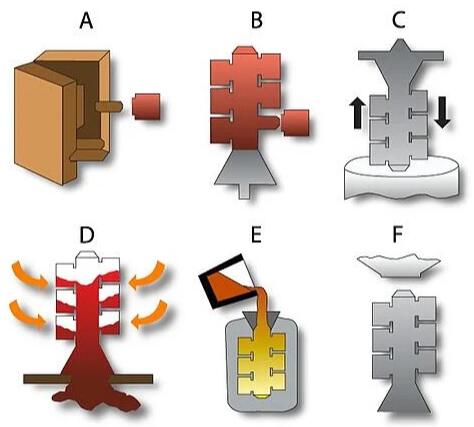
- English
- Español
- Português
- русский
- Français
- 日本語
- Deutsch
- tiếng Việt
- Italiano
- Nederlands
- ภาษาไทย
- Polski
- 한국어
- Svenska
- magyar
- Malay
- বাংলা ভাষার
- Dansk
- Suomi
- हिन्दी
- Pilipino
- Türkçe
- Gaeilge
- العربية
- Indonesia
- Norsk
- تمل
- český
- ελληνικά
- український
- Javanese
- فارسی
- தமிழ்
- తెలుగు
- नेपाली
- Burmese
- български
- ລາວ
- Latine
- Қазақша
- Euskal
- Azərbaycan
- Slovenský jazyk
- Македонски
- Lietuvos
- Eesti Keel
- Română
- Slovenski
- मराठी
- Srpski језик
What is Investment Casting and How Does It Work?
2022-09-09
Investment Casting (Lost Wax Casting)
Factors such as design requirements, cost, and feasibility to manufacture dictate which casting process is most suitable to manufacture a product. This article describing investment casting is intended to help you make an informed casting decision.
Investment casting produces precise components while minimizing material waste, energy, and subsequent machining. It can also ensure the production of very intricate parts. This makes the investment casting process quite useful to design engineers.
The goal is to understand what is meant by investment casting. So, What exactly is the investment in “investment” casting? The term “invested” historically carries the meaning of “clothed” or “surrounded.” Investment casting employs a shell made of ceramic, plaster, or plastic that is formed around a wax pattern. The wax pattern is melted and removed in a furnace and metal is poured into the shell to create the casting.
What is investment casting used for? Let’s break down the investment casting production process for a greater understanding:
The Investment Casting Process

Creating the Pattern
It utilizes a pattern with the same details as the finished part, except that there is an allowance for thermal contraction (i.e. shrinking).
Patterns are typically made of wax using a metal injection die.
Mounting the Wax Patterns and Creating the Tree
Once a wax pattern is produced, it is assembled with other wax components to form the gate and runner metal delivery system.
Depending on the size and configuration of the desired finish component, multiple wax patterns may be processed using a single tree.
The entire wax pattern assembly is dipped in a ceramic slurry, covered with sand stucco, and allowed to dry.
Cycles of wet dipping and subsequent stuccoing are repeated until a shell of the desired thickness is created. That thickness is partly dictated by product size and configuration.
Once the ceramic shell has dried, it becomes sufficiently strong to retain the molten metal during casting.
Wax Removal
The entire assembly is placed in a steam autoclave to melt away most of the wax.
Any remaining wax that soaked into the ceramic shell is burned out in a furnace. At this point, the residual wax pattern and gating material has been completely removed and the ceramic mold remains with a cavity in the shape of the desired cast part.
This high-temperature operation also increases the strength and stability of the ceramic material. In addition, it helps to minimize the reaction of the shell and metal during pouring.
Melt and Cast
The mold is preheated to a specific temperature and filled with molten metal, creating the metal casting.
Nearly any alloy can be produced using this process. Either air melting or vacuum melting may be employed as dictated by the alloy chemistry. Vacuum melting is utilized mainly when reactive elements are present in the alloy.
Final Operations
Once the casting has cooled sufficiently, the mold shell is broken away from the casting in a knockout operation.
The gates and runners are cut from the casting, and if necessary, final post-processing sandblasting, grinding, and machining is performed to finish the casting dimensionally.
Non-destructive testing may include fluorescent penetrant, magnetic particle, radiographic, or other inspections. Final dimensional inspections, alloy test results, and NDT are verified prior to shipment.
Advantages of Investment Casting Process
Size range:
Although most investment castings are small, the investment process can produce castings weighing more than 1,000 pounds. This capability is limited to a relatively small number of investment casters and requires special expertise in handling. Most cast parts fall in the ounces to a 20-pound range.
Versatile and intricate shapes:
Investment casting provides consistent and repetitive close tolerances along with intricate passages and contours. Many of these configurations are impossible to produce. For example, where machine tools cannot reach. Achieving net-shape or near-net-shape cast components can dramatically reduce post-cast processing costs.
Investment casting is a good alternative to weldments or fabricating. Many components can be combined into a single casting. The more that are combined, the better the manufacturing efficiency. Converting multi-piece components to a single investment casting typically delivers more dimensional accuracy and reduced part complexity.
Accurate and Smooth Surfaces:
The ceramic shell used is built around smooth patterns produced by injecting wax into a polished aluminum die. A 125 micro finish is standard, and even finer finishes are not uncommon.
Investment castings contain no parting line because only one mold is used rather than two half molds (such as in the case of sand casting). Standards for surface blemishes and cosmetics are discussed and agreed upon with the customer based on the function.
Below is a comparison of relative surface finishes that can be expected from various casting process:
| Casting Process | RMS Range |
| Die | 20 – 120 |
| Investment | 60 – 200 |
| Shell Mold | 120 – 300 |
| Centrifugal – Standard tooling | 400 – 500 |
| Centrifugal – Permanent Mold | 20 – 300 |
| Static – Permanent Mold | 200 – 420 |
| Normal Non-Ferrous Sand | 300 – 560 |
| Normal Ferrous Green Sand |
560 – 900 |
Edited by Santos Wang from Ningbo Zhiye Mechanical Components Co.,Ltd.
https://www.zhiyecasting.com
santos@zy-casting.com
86-18958238181



